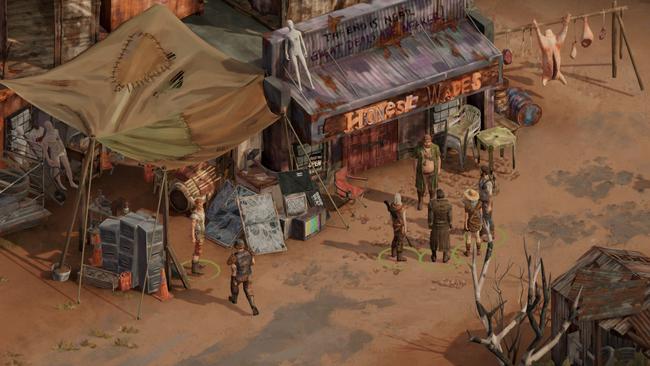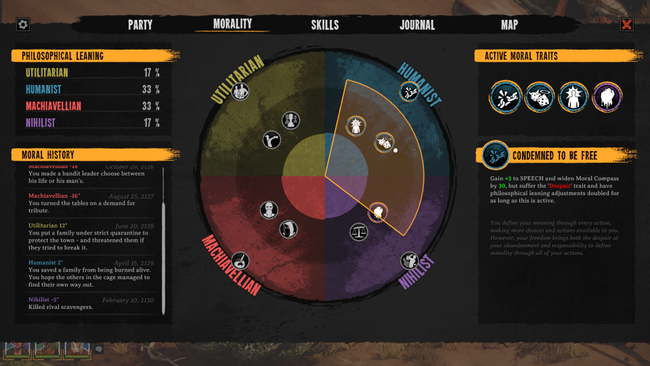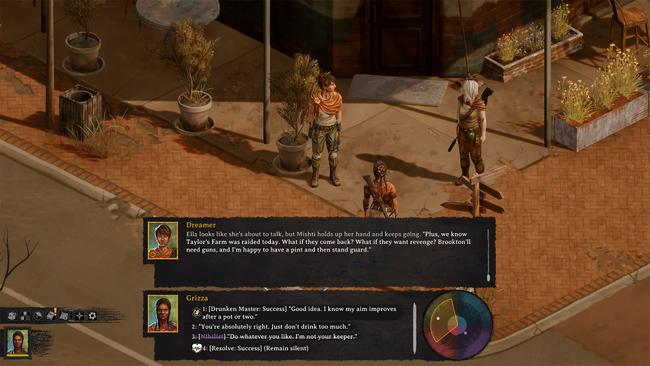
Broken Roads Interview: Painting the human experience against a desolate backdrop
Broken Roads, by Drop Bear Bytes, is an upcoming post-apocalyptic CRPG set in the Australian Outback. After playing part of the full build at PAX Aus, I asked the team my questions.

RPG Site: What was the reason to set the game out around Western Australia specifically, was it just the large swaths of land, or is anyone on the team from there?
Craig Ritchie, Game Director: We originally planned the game as a road trip starting in Perth and running to the Daintree in far north Queensland. It was going to be a generic post-apocalyptic world with tactical combat and resource management along the way. The more we got into the characters, story and locations, the more Jethro [Naude, co-founder of Drop Bear Bytes] and I realised we were making Broken Roads into a traditional CRPG.
So, we narrowed it down to just WA, and then just the Wheatbelt part of WA, going for depth instead of breadth. At the time, no one on the team was from WA, but we have since hired Amos Wolfe, our Lead Programmer, who is from Perth.
RPG Site: The art direction looks to be a blend between classic Australian landscape paintings and top down crpg style. Was there any inspiration in that regard, or just a natural consequence of portraying the outback?
Bianca Roux, Art Lead: We have done everything we can to stay true to Australia’s colour palette by having our team take trips to Western Australia, capturing well over 1000 photos of the various locations in the game, and researching numerous locations on Google Maps/Street View.
There was a process of research and development in exploring how to capture a hand-painted style on 3D characters, buildings, and objects. We leaned on researching many different games with similar styles, while still trying to create our own unique method. Our Texture Artist paints all the textures by hand, capturing large brush strokes, and thus, giving the world our unique painterly aesthetic. Our goal is to create a game where it feels like you are playing in concept art and we achieve this aesthetic with our method of hand painting 3D models.
RPG Site: What was the idea behind the morality compass? It almost seems like a political chart especially with the four philosophies it encompasses.
Craig Ritchie, Game Director: The Moral Compass came about from wanting to try a new way of handling alignment in video games. I didn’t want something too restrictive, so made it rotate slightly based on choices. We can all imaging multiple ways of dealing with things and this made sense for the world view (the golden arc), with slight shifts in degrees clockwise or counterclockwise depending on the choices the player character makes.
We then added the moral tendencies (the brighter areas at the centre of the compass) for low-level decisions in any quadrant as well as increasing the moral tendency by one (out of 100) with each decision in a particular quadrant. By allowing characters to be broad-minded or narrow-minded depending on if they made choices all over the compass, or only within their world view, we got a little bit more flexibility with it as well. There are definitely similarities to the appearance of some political charts, but this is more about providing a range of choices based on universal, group and individual values.

RPG Site: How much variance to the story will that bring, aside from the natural consequences of your actions? Will the overall story shake up much?
Leanne Taylor-Giles, Narrative Director: While the player’s involvement certainly changes the story, and how they engage with the world affects the decisions and direction of other characters living in that world, the player is far from the only person with agency. De-centralising the player character allows for interesting stories to be told on the periphery, or secondary to the player’s direct actions, and broadens the scope of the world to the point where it can exist as its own character. In that sense, there are certain events that will always occur, but how they occur, and whether they’re successful or not, depends on how the player interacts with the disparate pieces.
RPG Site: When I played the game at PAX Aus, you said the game was originally in 2D. What made you change that?
Bianca Roux, Art Lead: We decided to make the move to full 3D in 2021, and have found that this has benefitted us greatly. 3D models achieve more visual appeal in the lighting and rendering, as well as improve workflow speed by reusing, rotating, and re-texturing existing objects.
RPG Site: You also compared the games to the original Fallout entries, aside from the general combat style and choice driven gameplay, what else from that or other series did you bring into this game?
Leanne Taylor-Giles, Narrative Director: The sense of hope in Fallout 1 & 2, even when the story itself may have had a futile outcome, is something that inspired me a lot back in the day. The idea that nuclear war wasn’t the end of the world is, in itself, a hopeful proposition. The player’s ability to do both kind and dreadful things was also inspiring. We don’t learn about ourselves by ignoring our flaws, and we don’t learn about human nature by pretending that darkness doesn’t exist. Fallout managed to combine the duality of human nature with an optimism that wasn’t based on naivety, and I found that enormously compelling.
My experiences with Baldur’s Gate 1 & 2, and Planescape: Torment, of course also influenced the storytelling techniques I wanted to employ. Themes like being culpable for who you were born, trying to recover something beautiful that had been lost through your own actions, and using love as a weapon are many-faceted, ideal for contemplation. If the player finds themselves thinking of Broken Roads days, weeks, or even years after they finish it, that will be a testament to those games that first inspired us.
RPG Site: I liked the glossary pop ups for Australian terms, was that pre-emptive, or something developed after feedback?
Craig Ritchie, Game Director: We always wanted to do it from a pure lore perspective, as has been done in other games, but then with all the Aussie slang, we started adding to it until the ‘Cyclopedia and Glossary now have, probably, more definitions of Australian lingo than explanations of in-game lore.
RPG Site: One of the neater things I noticed, was that if you’d already met the conditions for a skill check it would simply pop up as an option, Was that there from the get go or?
Leanne Taylor-Giles, Narrative Director: One of the quality-of-life improvements we’ve made (as an industry) over the past 25 years is learning how to gate information much more cleanly. To that end, we’ve tried to make each conversation progress naturally, adding options when they would organically arise and leaving options that have no reason to time out. I don’t want a player to be hunting through three different hubs in search of an option they saw five minutes ago! The dialogue interface should be as frictionless as possible, since it’s merely a delivery system, and that’s the methodology that I’ve attempted to bring to conversation design in Broken Roads.
RPG Site: I saw a kangaroo around the crash site, though I couldn’t interact with it. Will the native wildlife play any part in gameplay?
Leanne Taylor-Giles, Narrative Director: Oh, yes. Yes indeed.
Bianca Roux, Art Lead: There are plenty of native creatures still to be added to the game before release, some of which include Koalas, Possums and Wombats. Many of them will run away naturally as would happen in real life - I won’t give any spoilers, but look out for some special quests and interactions to come.

RPG Site: Most importantly, can we get pissed [drunk]?
Craig Ritchie, Game Director: Haha yes indeed! There are a number of pubs, and a lot of beers in the game. There’s a brewery, a Drunken Master skill, and a couple other elements of the game revolved around beer.
Leanne Taylor-Giles, Narrative Director: You can get blotto!
RPG Site: Is there anything else you’d like to mention before the game’s release?
Bianca Roux, Art Lead: We have made tons of progress in terms of art direction in tying all the levels together in the last few months. I cannot wait for the public to experience the full game and appreciate the breathtaking scenes of post-apocalyptic Western Australia as much as we have.
Craig Ritchie, Game Director: Just that it has been a phenomenal experience seeing the game and studio go from an idea between two people to a close-to-launch product and a team of 15 nearly five years later. It’s been one hell of a journey and I’m very keen for it to be out in the wild next month.
Broken Roads is releasing on November 14th for PC and Xbox, with other systems to come later.